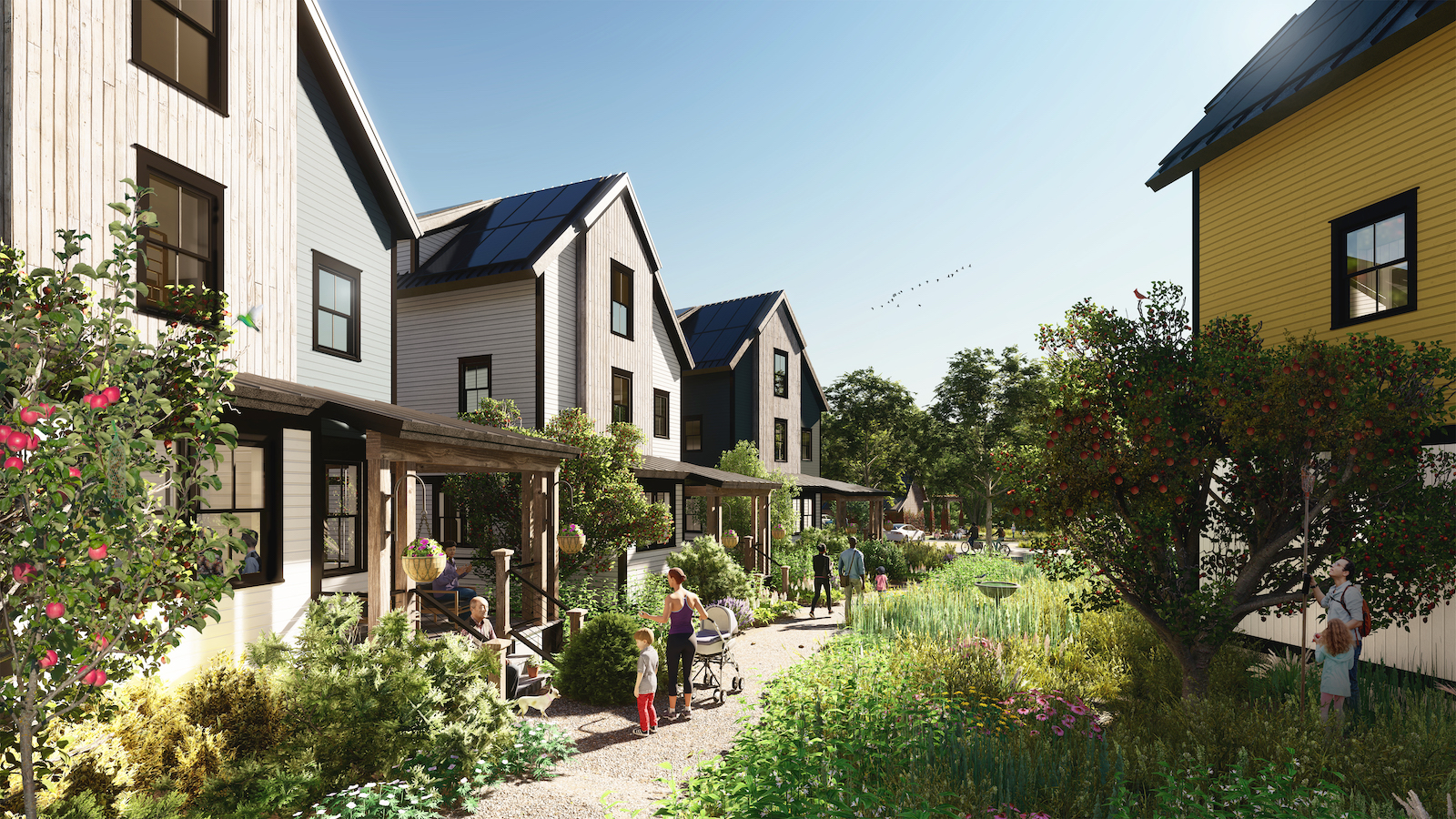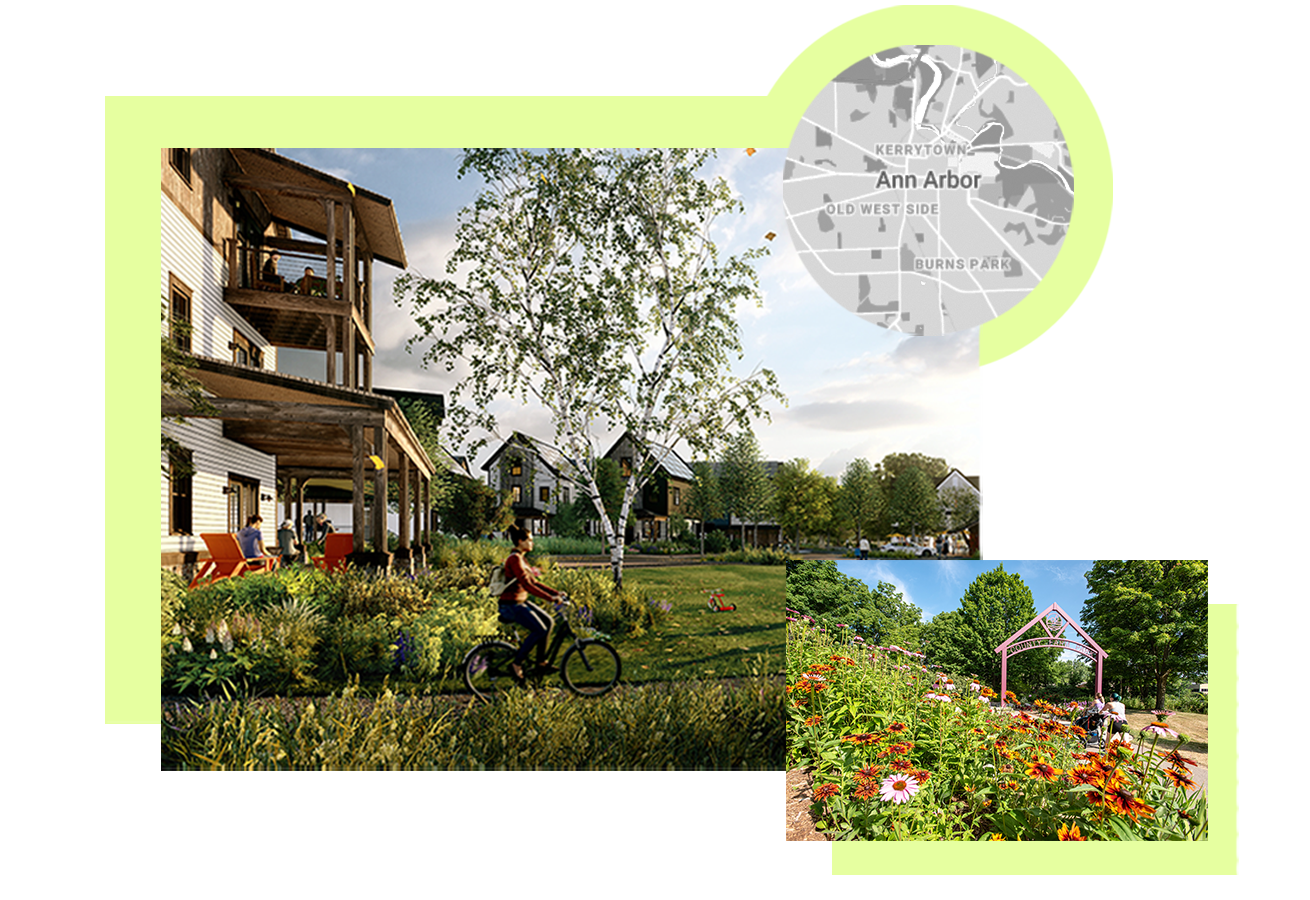Bordering more than 100 acres of trails and woods, a new sustainable housing development is taking shape in Ann Arbor, Michigan. Combustion appliances and gas infrastructure are prohibited in the bylaws. Instead, the community will be all-electric and powered through solar energy. It’s green down to the smallest details – with rules around everything from which lighting is allowed, to minimize disturbance of the local ecosystem, to the impact of heat pumps on sound ecology.
A third of the project’s landscape will be used for food production. But there will also be a grocery store, coffee shop, and community greenhouse on site. Bus lines, sidewalks, and bike lanes will connect the ecovillage to greater Ann Arbor, including a bustling shopping hub less than half a mile away.
The project, known as Veridian at County Farm, is being built on the site of a former juvenile detention center. And when it opens in 2023, it will be one of the country’s first mixed-income, net-zero energy communities.
It seems like the ecotopia that dreams are made of – one that urban planners see as a potential model for future development in a climate-conscious world.
If everything goes according to plan, “other developers should be looking to this as the gold standard of what we should be doing and building in communities across the country,” said Sara Hammerschmidt, a director at the Urban Land Institute, and member of the Ann Arbor Planning Commission.

In the United States, housing accounts for around 20 percent of annual greenhouse gas emissions. Heating, lighting, cooling, and powering appliances all contribute to the high amount of emissions, but energy efficiency upgrades like replacing windows and sealing air leaks can make a big difference. According to research from the World Resources Institute, to meet the goals of the Paris Agreement to limit warming to 2 degrees Celsius, all buildings, including houses, would need to be carbon neutral by 2050. Today, less than 1 percent are.
Unlike much of the sustainable architecture that exists today, Veridian will not be a retreat only for the wealthy.
There will be six different home designs, ranging in price from $180,000 to more than $900,000. And of the 160 units available, 50 are being developed by a local nonprofit partner, Avalon Housing, as affordable homes for people making less than 60 percent of the area’s median income. A portion of those will be set aside for people experiencing homelessness. Avalon will develop a community building on site that will provide support services to ensure housing stability, including crisis response and case management.
“This should be what people want developers to bring to the table in communities,” George Homsy, the director of the environmental studies program at Binghamton University in New York, told Grist. “That’s a huge commitment to affordability. I would love to see other developers and communities emulate that kind of ratio.”
Homsy also said the project’s sustainability is “no small feat in terms of greenness.” The development will be a certified Living Building Challenge, an international sustainable building certification that requires buildings to produce more energy than they use, or create a positive impact on the environment. It’s an involved process, Homsy told Grist, one that he knows well, as he’s trying to get a Living Building on his own campus.
“It’s exciting that they are able to put this affordable housing component in there,” Homsy said. “It just shows that with the right partnerships, affordable housing can be an integral part.”
The founder of Thrive, the real estate firm behind Veridian, Matthew Grocoff, does indeed hope it can be a model for other cities across the country. “I truly believe that setting these targets of 2050 and whether or not we can meet these goals is really just kind of a lack of imagination of what’s possible today,” he said. “It’s not some sort of far off 2050 imaginary place. It’s real, and it’s now, if we choose it.”

The move to build communities like Veridian seems to be growing.
“We have seen an increase in recent years of people interested in ecovillages and sustainable living in general, especially in the pandemic and post-pandemic context,” Ruben Gutierrez, from the Global Ecovillage Network, told Grist. The group is an alliance founded nearly three decades ago to help encourage more sustainable living around the world, with small communities like Veridian.
According to Team Zero, formerly known as the Net Zero Energy Coalition, the number of net-zero housing units in the U.S. and Canada has more than quadrupled since 2015, growing from 6,177 units to 27,965 units in 2020.
Grocoff has long been passionate about housing sustainability. In 2015, his own home in downtown Ann Arbor became the first in a cold climate to be certified as net-zero energy through the Living Building Challenge. The home was built in 1901 and was the opposite of a healthy, sustainable building. It had asbestos siding, lead paint, a gas-powered furnace, and no insulation. After making some changes, the house is now the first historic home, globally, to be certified through the Living Building Challenge, and proved Grocoff’s point that if you can do it in a home like that, anything is possible.
In 2018, Thrive gained approval from Ann Arbor city commissioners to develop on the land. They’re expecting to break ground any day now. The support from the community has been very enthusiastic, Grocoff told Grist. Nearly 400 people have filled out a homebuyer survey indicating they would like to purchase a home. Residents will be chosen on a first-come, first-served basis.
“These kinds of developments are a positive step forward,” Homs said, “but the system shouldn’t be set up in such a way that they are so rare. We need to set up systems at the local, state, and national level to make this the norm.”




